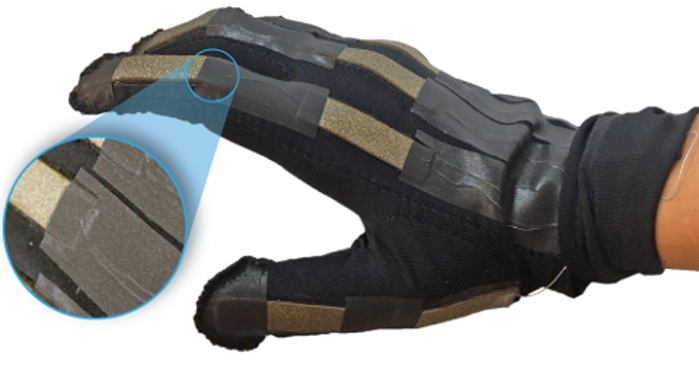Fast route to sustainable logos with Compo-SiL
Smart Textiles
Silicone fabric sensor for smart robotic apparel
Hybrid silicone-fabric sensor detects fine motor movements by flexing with the body.

28th July 2017
Innovation in Textiles
|
Cambridge, MA
A team of researchers at the Wyss Institute for Biologically Inspired Engineering and the Harvard John A. Paulson School of Engineering and Applied Sciences (SEAS) has created a highly sensitive soft capacitive sensor made of silicone and fabric that moves and flexes with the human body to unobtrusively and accurately detect movement.
“We’re really excited about this sensor because, by leveraging textiles in its construction, it is inherently suitable for integration with fabric to make ‘smart’ robotic apparel,” said corresponding author Conor Walsh, PhD, Core Faculty member at the Wyss Institute and the John L. Loeb Associate Professor of Engineering and Applied Sciences at SEAS.
“Additionally, we have designed a unique batch-manufacturing process that allows us to create custom-shaped sensors that share uniform properties, making it possible to quickly fabricate them for a given application,” commented co-author Ozgur Atalay, PhD, Postdoctoral Fellow at the Wyss Institute. This research is published in the current issue of Advanced Materials Technologies.
Technology
The Wyss team’s technology consists of a thin sheet of silicone sandwiched between two layers of silver-plated, conductive fabric, forming a capacitive sensor. This type of sensor registers movement by measuring the change in capacitance, or the ability to hold electrical charge, of the electrical field between the two electrodes.
“When we apply strain by pulling on the sensor from the ends, the silicone layer gets thinner and the conductive fabric layers get closer together, which changes the capacitance of the sensor in a way that’s proportional to the amount of strain applied, so we can measure how much the sensor is changing shape,” explained co-author Daniel Vogt, Research Engineer at the Wyss Institute.
Novel manufacturing process
The hybrid sensor’s performance stems from its novel manufacturing process, in which the fabric is attached to both sides of the silicone core with an additional layer of liquid silicone that is subsequently cured. This method allows the silicone to fill some of the air gaps in the fabric, mechanically locking it to the silicone and increasing the surface area available for distributing strain and storing electrical charge.

This silicone-textile hybrid is said to improve sensitivity to movement by capitalising on the qualities of both materials: the strong, interlocking fabric fibres help limit how much the silicone deforms while stretching, and the silicone helps the fabric return to its original shape after strain is removed. Finally, thin, flexible wires are permanently attached to the conductive fabric with thermal seam tape, allowing electrical information from the sensor to be transmitted to a circuit without a hard, bulky interface.
Strain experiments
The team evaluated their new sensor design by performing strain experiments in which various measurements are taken as the sensor is stretched by an electromechanical tester. Generally, as an elastic material is pulled, its length increases while its thickness and width decrease, so the total area of the material – and, therefore, its capacitance – stays constant.
Surprisingly, the researchers found that the conductive area of their sensor increased as it was stretched, resulting in greater-than-expected capacitance. “Silicone-based capacitive sensors have limited sensitivity based on the nature of material. Embedding the silicone in conductive fabric, however, created a matrix that prevented the silicone from shrinking as much width-wise, which improved sensitivity above that of the bare silicone we tested,” said lead author Asli Atalay, Postdoctoral Fellow at the Wyss Institute.
Future directions
While this study is a preliminary proof-of-concept, the team is excited about the many future directions in which this technology could develop. “This work represents our growing interest in leveraging textile technology in robotic systems, and we see promising applications for motion capture ‘in the wild,’ such as athletic clothing that tracks physical performance or soft clinical devices to monitor patients in their homes. In addition, when combined with fabric-based soft actuators, these sensors will enable new robotic systems that truly mimic apparel,” said Walsh.
“This technology opens up entirely new approaches to wearable diagnostics and coupled therapeutics that undoubtedly will pay a central role in the future of home healthcare,” said Wyss Founding Director Donald Ingber, MD, PhD.

Business intelligence for the fibre, textiles and apparel industries: technologies, innovations, markets, investments, trade policy, sourcing, strategy...
Find out more











